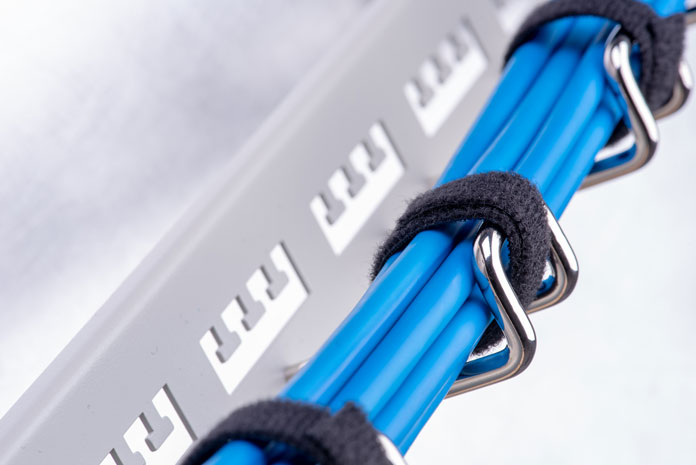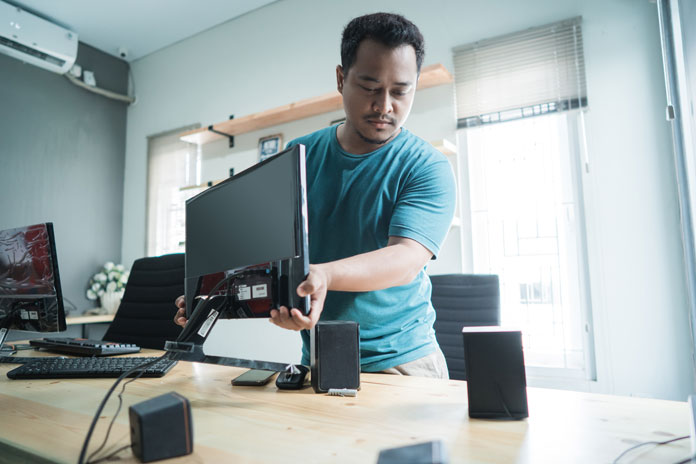Not just on the computer or laptop. Also with other technical devices, such as in the kitchen. It usually develops on its own over time. Ove...

Tangled cables hinder us.
Not only that tangled or hanging cables are a constant tripping hazard. They are also constantly in the way. With every movement, a cable is caught and pulls some device with it. In the worst case, the expensive monitor crashes onto the floor. Or the cable is pulled and the connection tears off. Then you can stop working or gambling and think about how best to get it repaired.
The work is also hampered by the fact that thousands of small things disappear in the cable clutter. While looking for the USB stick that just fell down, we find all sorts of things, but unfortunately, the tiny stick remains as if swallowed up by the earth. When rummaging, we move the cables so roughly that, see above, something falls off the desk with a crash.
Cable clutter costs.
It costs nerves anyway, but hard cash is also lost. Not only that devices and connections are constantly broken when the cable is involuntarily pulled again. The cables themselves also break sooner if they are not properly laid and are constantly in motion. This then takes time to find the error. The troubleshooting could not only have been avoided but is also so time-consuming due to the poor cable management that you are wondering at the latest at this point why you didn't take care of it sooner.
In addition, due to the poor cleaning options, it is not necessarily particularly pleasant to check the tangled cables for errors.
That's why cable management is important
Do you want to work and play or deal with troubleshooting and repairs? So what. This only requires a small investment of time in proper cable management at first and then saves you pointless crawling behind your desk.
A tidy desk not only pleases the eye but also looks beautiful. It's also more practical. Cleaning and dusting are faster and easier.
The cables are no longer moved unintentionally because they are all neatly in their place where they do not get in the way. And the clutter of cables doesn't distract attention from the important things in the workplace either.
Nothing is in the way.
Replacing individual devices works quickly and effectively thanks to clear cable routing.
Our 12 tips for effective cable management
1. Planning and anticipating cable management
Even if every desk is structured differently and you don't yet know which devices will be added in the future, you should give some thought to the future.
Even if you only start with a laptop and a mouse, you can already think about where there might be space for additional devices and how the cables can be routed most effectively.
Typical additional devices that almost everyone sooner or later acquires are, for example, an extra-large monitor and a keyboard. Both are inexpensive to purchase and therefore popular as supplements. They make many activities easier. The place of the two devices is more or less predetermined by their function.
But a printer or an external hard drive is also necessary if required. The printer in particular is usually so large that there are usually not many options for choosing a location.
If you take this into account during your planning, you will hardly have to put any effort into laying the cables later.
2. Use technical tools to bundle cables
The simplest and cheapest tool is a resealable cable tie. This is simply a small plastic strap with Velcro. This allows multiple cables to be easily bundled and also easily removed again.
Extra tip: A cable can be detached very easily with two cable ties in a row. First, remove from the first cable tie, then close again. Then loosen it from the second cable tie and also close it again. This will prevent you from falling out and having to rearrange all the cables.
Cable ties are not only good for bundling individual cables. You can also use it to fix the bundle to your desk yourself.
Cable hoses are also available as an alternative to cable ties. They work similarly but have a wider band. Thus, the cables are well packed over a longer length. Another advantage is that they are well-protected.
Try to use European products whenever possible. They only cost a few cents more, but they last longer and most importantly, they smell less like cheap plastic. The smell of chemicals in the workplace does not necessarily promote concentration.
3. Use technical aids to bridge long distances
Now and then longer distances have to be covered. Loose cables lying around harbor the corresponding dangers. Bundling the various cables in a few places is often not enough. A better solution is needed. In this case, cable ducts have proven their worth.
These cable tunnels are made of plastic, aluminum, or stainless steel. Inexpensive plastic ducts are sufficient for simple applications. They can often even be laid without drilling and can be easily attached with double-sided adhesive tape.
If you want it to be more stable, then grab metal, which you can then lay securely with dowels and screws.
If the canal has running paths, make sure it is flat enough that no one will trip.
4. Use fewer cables
You can now connect the mouse and keyboard via Bluetooth. The printer is controlled via WLAN and the Internet router no longer requires a cable that runs through the entire apartment.
If you have long distances to the bridge, you can use the repeater. However, it halves your WLAN rate. If the wireless WLAN is not enough or if you do not want it to be halved, you can use so-called Powerline adapters. The Internet is fed directly from the router into the socket via cable and can be tapped at any other socket using an adapter. Then the cable only has to bridge a small remaining distance.
This saves you from having to lay cables through the whole apartment.
5. Use technical aids, such as mailing lists
Many devices that connect via Bluetooth require a USB port. Not every computer has that many connections. Distributors with multiple USB or HDMI ports are helpful. So everything runs through one central point.
6. Use the technical tools of your devices
Most monitors or mounts already have devices that you can easily use. This means they are already invisibly guided down to the table.
7. Use the tech tools at your desk
Of course, it is most practical if the cables routed downwards, for example from the screen, would then disappear directly into the desk. Some have extra openings where the cables can then disappear cleanly. If not, you can consider drilling your own hole. But you have to decide that individually.
There are attachments for cable bushings on the market that have another advantage for your cable management in addition to a better look. You can hide a not so perfectly drilled hole quite well. These attachments are also available with recessed, retractable sockets or USB ports.
8. Use technical aids such as magnetic holders
The principle is simple. A magnetic clip that attaches to the cable is designed to stick to a magnet attached to the desk. You have to decide to what extent this makes sense for you or not.
No products found.
9. Use technical aids such as cable trays
A cable tray hangs under the desk and catches the cables that are routed from above, down from the desk. This means that the cables do not hang down and are bundled and routed over a certain distance. This makes vacuuming under the desk easier. In addition, the cables do not get in the way, are practically invisible and individual multiple sockets also catch them effortlessly.
These are sometimes included on more expensive desks. But you can also easily retrofit them.
10. The universal all-purpose weapon: double-sided adhesive tape
Double-sided tape is always present in a good household. This means that all kinds of auxiliary constructions can also be attached to cable management without having to drill holes straight away. The double-sided tape can also be removed again. in contrast to the drilled hole.
11. Use as long cables as possible
Especially with height-adjustable desks, the cables should be long enough so that the movement of the desk does not become a test of strength between the electric motor and the cable connection. One end of the wire harness should be firmly fixed. The other must be able to move with the desk. This requires length and guidance.
But longer cables are also generally an advantage. The variability and design options of good cable laying are inevitably greater with longer cables.
12. Check from time to time whether everything is still properly laid
More and more will be added over time. Devices disappear, new ones are purchased. Clean cable routing is not always taken into account when installing them.
So take some time every now and then to reroute all the cables. Continuous improvement is easier and faster than having to tackle the issue after a long time or in an emergency. You always want to play and work without interruption.















COMMENTS